How Much Does a Domain Name Cost? Everything you Need to Know!
- By
- Last updated:
- Leave your thoughts
A domain name is one of the essential elements you’ll need to create a website. It’s basically a memorable way of showing your site’s address, so visitors can easily find it. But how much does a domain name cost? And are there any hidden fees to worry about?
Depending on the goal of your website and the type of name you want, a domain name can set you back anything from a few dollars all the way up to thousands, and there could also be some hidden costs that pop up.
But once you learn more about domain names and how the industry prices them, the costs will start to make a lot more sense and be easier to navigate.
In this article, I’ll be answering the question of how much a domain name costs and giving you more detail on domain names in general, the different types, and what you need to know to get the one you want.
Table of Contents
- Domain Name Cost: The Basics
- When You Need a Domain Name
- Where You Can Get a Domain Name
- How Much Does a Domain Name Cost?
- Final Answer: How Much Does a Domain Name Cost?
Domain Name Cost: The Basics
Before diving into domain name costs, it’s crucial to understand what a domain name is, as well as the different kinds that are available, so you can understand why prices seem to differ so widely.
Domain Names Explained
When you open a browser to visit a website, typically you type a domain name into the address bar. Then, the site loads after you press Enter on your keyboard.
A domain name consists of three main parts separated by full stops: A subdomain, the domain name, and the Top-Level Domain (TLD) extension. Each of these segments are called labels.
Typically, the whole kit and caboodle is referred to as a domain name by most users.
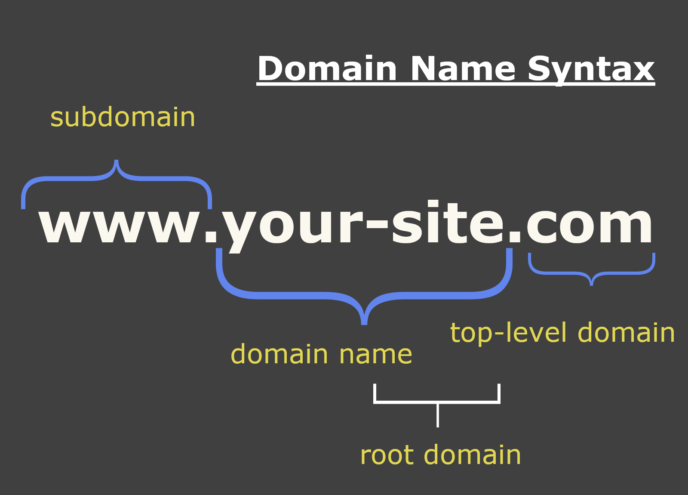
For example, for the domain www.your-site.com the subdomain is ‘www.’ The chosen domain name is ‘your-site’ and the TLD is ‘.com’.
A subdomain is the part of the address that can optionally be used to subdivide the domain name.
You can set the domain name to point to one page or website, then make the subdomain point elsewhere. Or, you can choose to use the default subdomain ‘www’ which is an initialism for World Wide Web. You can also choose to completely omit a subdomain when you set it up. It would look similar to your-site.com, in such a case.
After the optional subdomain and a period comes the domain name label. It’s the customizable string of letters or numbers that make up the memorable part of the domain. That’s what most people choose based on the website or business’s name.
After another full stop is the TLD. It’s the domain’s extension that was originally designed in the 1980s to categorize a domain, and, by extension, the website that pointed to it.
TLDs, Country Codes and Second-Level Domains
The original TLDs that were created were:
- .gov for government websites
- .edu for educational institutions
- .com for commercial websites
- .mil for the military
- .org for an organization, especially non-profits
- .net for websites that were networks
- .int for international organizations
Since then, .com and .net extensions have been opened up for general use.
Country codes are also used alongside TLDs, and are domain extensions that consisted of two letters that signify a country. They can be registered by anyone, but are best suited to websites that focus on the country of origin or the local area.
Since then, more TLDs have been released as there was a need for them. Now, you can search through more than a thousand TLDs from .shop and .live all the way to .legal, .dental, or .xyz.
You can pretty much find whatever TLD you want nowadays.
You may have also come across a Second-Level Domain (SLD) which is a secondary portion of a TLD that comes before the TLD and is separated by a period. For example, in the domain www.your-site.co.uk, ‘.co’ would be the SLD.
A domain can also continue in this fashion with third or fourth-level domains and so on.
Premium Domains
Domains that are pre-owned and are considered more valuable than the average domain are called premium domains.
In short, highly memorable and marketable or otherwise well-established domains with a strong SEO history are considered to be of higher value. Domains that consist of only two letters are also regarded as highly valuable.
For example, the most expensive premium domain that has been sold to date is cars.com for $872 million. If you own one of these premium domain names, you could potentially sell or auction them for thousands of dollars.
On the flip side, you can also purchase a premium domain, but keep in mind that with premium domains there’s a hefty initial cost, and sometimes the renewal price or transfer fee may also be higher.
More details on specific domain name costs are covered later on.
How Domain Names Work
It may also be important to note that domain names are different from websites. This means you can purchase a domain name without having to purchase anything else.
A domain name points to a website, which has the content stored on a server. They’re connected by a Domain Name System (DNS) service.
The server the website is stored on has an IP address, which has several sets of two or three numbers separated by full stops such as 12.345.678.90, for example. You can visit a website with its IP address, but IP addresses are difficult to remember.
Also, if a website uses shared hosting, then multiple sites are stored under the same server and IP address. While this isn’t always the case, it does prevent access to any of the sites when the IP address is entered. That’s where a DNS service comes in. It connects a website with the corresponding domain name through an IP address or nameservers, although the option that’s used depends on the hosting provider and how the server is set up.
Either way, when someone enters the domain name into their browser, the DNS service is called, the corresponding server details are retrieved and a connection can then be established. This is when the website loads for the end user.
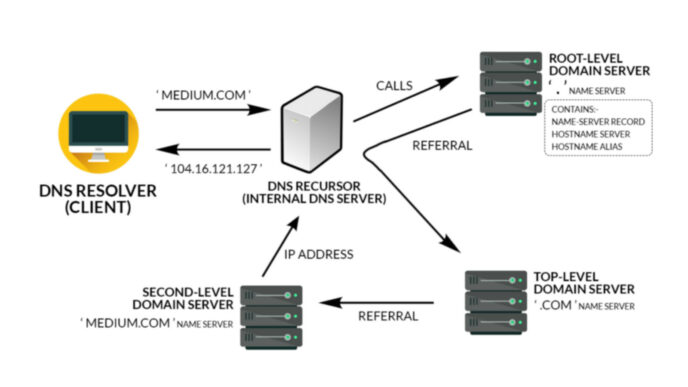
It may also be important to note that while there are similarities between a DNS service for a web server and the DNS connected with your Internet Service Provider (ISP) they aren’t exactly the same.
What It Means to Buy a Domain Name
It’s common to mention buying a domain name if you want to create a website, but you can’t technically buy a domain — you rent one.
They’re not free because of the costs associated with running a domain registrar, but many do offer a domain name at no extra cost when you purchase website or email hosting.
Otherwise, be wary of sites that offer domain names for free without purchase, as they typically offer low-quality TLDs that aren’t recognized favourably.
The prices you see advertised by domain registrars are for one year of renting the domain name. During this period of time, you essentially have the same rights to the domain name as if you did own it. You can choose to renew the domain after the first year to keep using it or you can let it expire and potentially let someone else buy it and use it.
It’s also possible to purchase your domain name in one-year increments for up to ten years at a time. Signing up for multiple years at a time can help to prevent expiration, although most domain registrars offer automatic renewals anyway.
Domains and How They Affect SEO
While domain names don’t play a starring role in and of themselves when it comes to Search Engine Optimization (SEO), they’re still a notable factor when being considered alongside your website’s SEO.
However, it’s not so much the domain itself that affects SEO, but the surrounding factors of the website and the websites historically attached to the domain.
Here are the main ways a domain name can positively impact your site’s SEO:
- The IP address previously associated with it wasn’t blacklisted.
- The domain has a past of high traffic.
- It’s highly memorable, marketable and short.
- It contains one or more popular keywords.
Please note: If a domain contains a popularly searched keyword, but the website doesn’t contain related content, then the site’s SEO won’t be positively impacted.
If you’re wondering just how long you should register your domain for, go for whatever’s comfortable to you.
It’s a common suggestion to purchase a domain for multiple years on the grounds that the domain’s age is a factor for SEO. However, Google’s Matt Cutts has noted:
‘To the best of my knowledge, no search engine has ever confirmed they use length of registration as a factor in scoring. If a company is asserting that as a fact, that would be troubling. The primary reason to renew a domain would be if it’s your main domain, you plan to keep it for a while, or you’d prefer the convenience of renewing so you don’t need to stress about your domain expiring.’
– Matt Cutts
Continuing on that note, it’s also a myth that the type of TLD is a ranking factor, except in the case of country code domain extensions. They indicate to search engines that your site and its content are relevant to a specific country.
Buying Domain Variations for SEO
Many domain registrars ask you if you want to purchase your domain name with alternate TLDs for SEO purposes when you try to check out.
For example, if you wanted to get your-site.com, you’ll be asked if you also want your-site.net, your-site.org, your-site.shop and possibly variations or misspellings of the name you chose.
The main reason why this is mentioned as an SEO strategy is because when you buy the domains, you can redirect all of the traffic to your main site, and it prevents others from buying those domains and competing with your site in terms of SEO.
Not to mention the fact that a spammer or hacker could buy them and create a convincing copy of your site to trick users into handing over sensitive information.
While it’s an entirely optional step, it’s a good idea to also grab the top TLDs for your chosen domain name.
That is, if you’re planning for consistent and rapid growth, such as for business websites. The more traffic you get to your site, the more hackers will take notice and find ways to attack it. So, if you’re creating a website for fun, you probably don’t have to worry about it right out of the gate.
Don’t worry about getting all of the TLDs, either. Focusing on the most popular ones is best since the others are far less common and likely won’t see any traffic for you to redirect. If a hacker purchases your domain but with a TLD that’s lower in value, it’s more likely users will be able to spot the difference.
In such cases, it’s the tiny, one-letter difference between your-site.co and your-site.com that’s more concerning and not so much a your-site.biz domain, for example.
Trust Is a Factor for TLDs
Another factor that indirectly affects SEO is the overall credibility of a domain name. If users don’t trust the TLD, they’re less likely to visit the corresponding website. This will negatively affect your site’s SEO.
Currently, the most popular TLD is the .com.
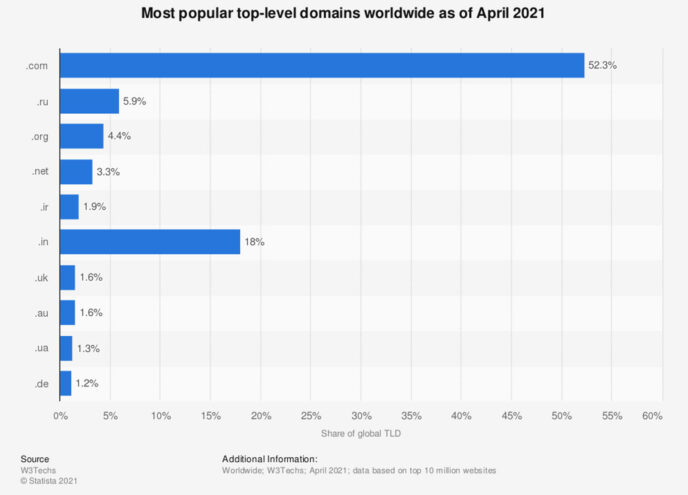
It’s also the most memorable and trustworthy of all TLDs. Out of 1,500 users in the sample size, 57 of them incorrectly assumed a site ended with a .com. While that’s a small percentage of people who responded that way, it’s still far greater than any of the other popular TLDs.
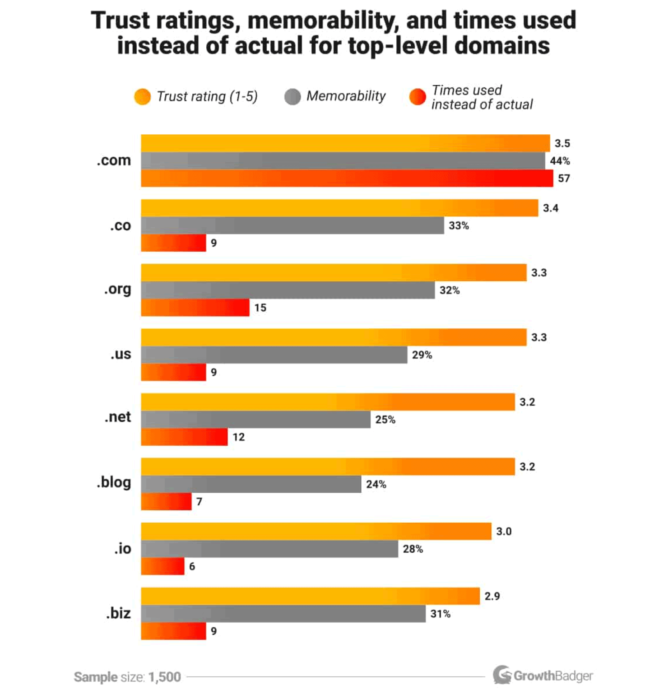
That being said, that doesn’t mean a .com is the only trusted TLD; users will still find most other domain extensions to be relatively trustworthy.
Avoid Widely Abused TLDs
Some TLDs are widely known to be used for spam or other similar reasons, which why .biz is seen as much less trustworthy, along with the list below of the top ten most abused TLDs in the findings from Spamhaus.
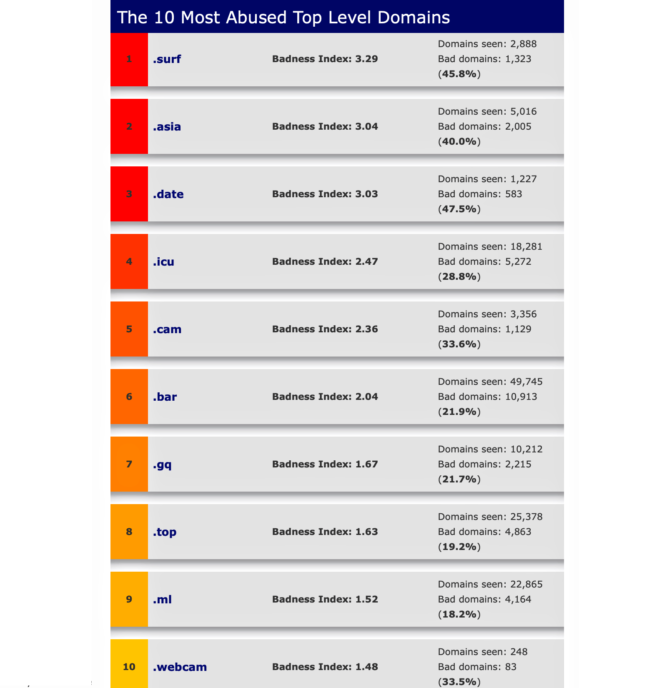
It’s a good idea to steer clear of using these TLDs, at least if you want to run a business or if you want to grow your site. Unless the domain is incredibly memorable and fits with your brand, it’s worth considering other TLDs that aren’t widely abused.
Country Code TLDs Are Fairly Trustworthy
When it comes to the trustworthiness of Country Code Top-Level Domains, (ccTLDs) users tend to be split nearly in the middle.
Respondents of a study conducted by Moz were asked to pick between two sites: One with a ccTLD and the other using a .com. They needed to decide which site they thought would have the most reliable shipping.
While 40% chose the .com site, 40% of the respondents said they viewed both as being similar and were indifferent to the TLDs that were used.
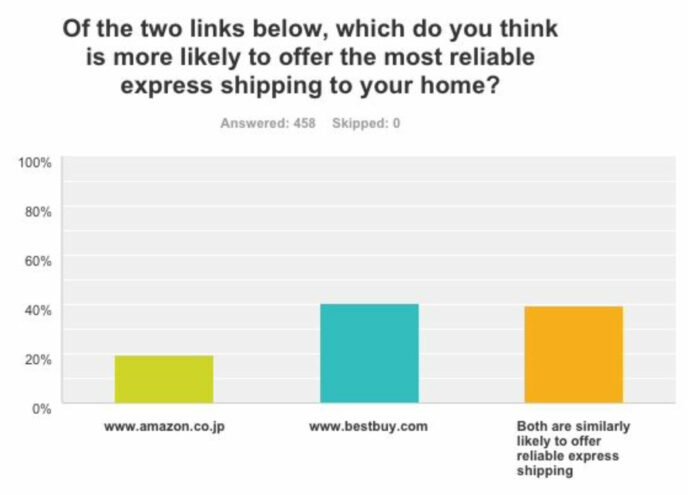
The other 20% of users favored the site using the ccTLD.
This demonstrates that while .com is still top dog, ccTLDs are a pretty close second. So, unless the domain extension you’re thinking of using is well known for spam, you’ll likely be okay.
At the end of the day, your website’s content and branding will be the most valuable aspects to consider for SEO.
When You Need a Domain Name
Now that’s all out of the way, do you even need a domain name? The reasons why you would need one are that you:
- want to create a website
- are considering or creating a business
- want it as an investment
- need to reserve the domain for future use
- don’t want others using the domain for malicious reasons
- want to prevent competition
- want your site to appear professional
- need to protect your trademark.
While you can sign up for a free website-creating service that will provide you with a subdomain or subdirectory domain for free, it doesn’t look as professional as a fully branded domain.
It’s the difference between using your-site.not-your-brand.com or not-your-brand.com/your-site versus your-site.com. The latter looks much more professional.
So, if you relate to any of the reasons listed above, you’ll need your own domain name.
Where You Can Get a Domain Name
Once you’ve determined you want to buy a domain name, you can get one from a domain registrar.
It’s a business that has registered with The Internet Corporation for Assigned Names and Numbers (ICANN) which is a non-profit organization that coordinates and facilitates the maintenance and organization of IP addresses and domain names.
Once the business is registered, it can start an application to register a select number of TLDs. Once the TLDs are registered, domain names can be sold with those select TLDs.
This means the domain registrar can only sell domain names for the TLDs that it’s previously been registered to sell. But does it matter where you buy your domain name?
Be aware that not all domain registrars are made alike. Just as with any business, some are trustworthy and reliable while others… well, not so much.
There are hundreds out there, so you’ll need to do a bit of research on which ones have the TLD you want at a price that’s fair to you.
Where to Buy a Domain Name
To help you to shorten your search, here are some of the top domain registrars and the domain name costs for the most popular TLDs for the first year:
| Domain Registrar | .com | .co | .net | .org | .io | .us | .blog |
| Namecheap | $8.88 | $7.98 | $10.98 | $9.18 | $32.98 | $3.88 | $6.98 |
| Google Domains | $12.00 | $30.00 | $12.00 | $12.00 | $60.00 | $12.00 | $30.00 |
| Network Solutions | $9.99 | $4.99 | $9.99 | $9.99 | $79.99 | $9.99 | $39.99 |
| Zoho | $10.00 | – | $12.00 | $11.00 | – | – | – |
| Domain.com | $9.99 | $10.99 | $12.99 | $8.99 | $47.99 | $4.99 | $6.99 |
How Much Does a Domain Name Cost?
It may also be important to note that some domain registrars also sell website and email hosting as well as other features and services. While you don’t have to buy them when you purchase your domain name, they can support you in running your business efficiently and effectively.
However, there are drawbacks, such as if you end up deciding the business isn’t reliable or trustworthy and you want to switch. It can be a really huge hassle to migrate everything over (although not impossible), and may require some time and monetary investment down the line.
Also, if everything’s under one business, a hacker could potentially gain access to everything. If they know what they’re doing and if the registrar isn’t secure, it could be accomplished within minutes or hours. That’s also why it’s crucial you choose a domain registrar that takes security seriously, especially if you decide to purchase multiple products with your domain name.
That being said, it’s enticing to want to get everything at once, especially when there are so many introductory offers and sales for new customers. However, those can also come with fees and exceptions that are standard practice in the industry, and it can be confusing to navigate at first.
What Affects Domain Name Costs
So, detailed in full below are the typical costs and fees associated with buying a domain name and what you need to know to better help you in estimating just how much you can expect to pay for yours.
Domain Registrar Pricing Structures and Deals
There are typical deals that domain registrars offer when you’re looking to buy a domain name, and here’s an incomplete list:
- A discount for the first year, then higher renewal rate.
- Free domain with website hosting purchase.
- If you also get email hosting, you can register a domain for free.
- Or the other way around, where you get free email hosting after buying a domain.
- Free WHOIS privacy with domain name.
- A discount for locking your name in for multiple years.
- Various free services with domain.
It may also be important to note that you should check the fine print with any deals you see as there may be extra hidden fees or additional domain name costs associated with any add-ons you purchase.
For example, domain name privacy is usually around seven to ten dollars per domain if it’s not free.
Domain Name Costs: Type of Domain
As previously touched upon, there are also two types of domains that will affect the domain name cost: Premium domains and the type of TLD.
Premium domains can range from a few hundred dollars to thousands or millions.
There are different prices for TLDs and ccTLDs that range from 99 cents to around $10 or $25 yearly, and there are also many others that come to more than a hundred dollars a year.
Domain Name Value
If you’re interested in buying a premium domain or you want to know the value of a domain name you have, you can estimate the value of the domain with any of the following tools:
Once you know what the value might be, you’ll have a better idea of what you should set for the price, or otherwise what kind of offer or bid you should make.
Some of the tools on the list, such as DomainIndex, also let you know advanced details including the performance of the domain’s keywords in search engine results. That way, you can estimate how much traffic you may get, since that has a lot of added value.
You can also choose to put in an offer on a domain that’s already owned, but that will require a domain name broker or similar service, which is an added expense. A popular option is Sedo.
Similarly, you can sell your domain at auction or set a price, as well as backorder an owned domain, so you’ll have first chance at the domain if it expires. All of these services also come with an additional fee, but the good news is that many domain registrars offer these kinds of options.
ICANN Fee
No matter what kind of domain name you do end up buying, ICANN charges a fee to the domain registrar that’s passed on to you, and is used to fund the non-profit. This fee isn’t typically included in the original price or even for any sale pricing, and is added to your order at check out.
Fortunately, it’s only about 18 cents, so it’s nothing to really worry about.
Domain Name Cost for Transfers
If you purchase the perfect domain name and find out later that there’s a better deal elsewhere, you can transfer your domain name to the new registrar.
Many registrars charge a fee to transfer the name, and it’s usually around ten dollars, but often it includes a year’s free extension on whatever time left you have on your domain before it’s set to renew or expire.
You may also see offers for a discount on any additional years you want to renew your domain for at the same time you complete the transfer. There are also a few niche registrars that offer free domain transfers, but if you wish to transfer it away later on you pay the transfer fee then.
Be aware that after you transfer your domain, it’ll be locked for 60 days. This means you won’t be able to transfer it again until that time period is over.
What to Consider When Buying a Domain
Besides domain name costs and other factors already mentioned, there are additional points worth considering when you’re buying a domain:
- Search to see if competitors are using a similar name already.
- Check social media to see if you can get the name there as well.
- Search the domain and see if there are related unsavory hashtags in use.
- Check your domain against existing trademarks.
- Consider not using hyphens since they’re not easily remembered.
- For new businesses, avoid naming your company with punctuation.
What If You Can’t Find Your Desired Domain Name?
If you run some searches and find your name is already in use or trademarked, it’s a good idea to brainstorm new ideas to prevent possible legal issues down the road.
Avoiding punctuation in your business’s name, as well as in your domain, also helps to prevent confusion for users if they need to guess what your domain name is at some point.
If you keep trying to find a domain name that isn’t taken and you’re not having any luck, try misspellings or adding extra letters if it fits your site’s branding. You can use sites such as Reddit, Dribbble or Scribd as inspiration, and don’t be afraid to get creative.
What Domain Name Should You Get?
With all of this in mind, what domain name and TLD should you get? Well, it all depends on your branding, needs, projected value of your site or business, budget, and what you’re willing to spend.
Ultimately, the domain name costs you can expect and what’s reasonable for you to pay essentially come down to your situation and your goals.
How to Check if Your Desired Domain Is Available
Once you’ve done your research and determined which domain registrar you want to use to buy your domain, you can visit its website.
Most, if not all of the time, there will be a search bar toward the top of the page where you can enter your desired domain name.
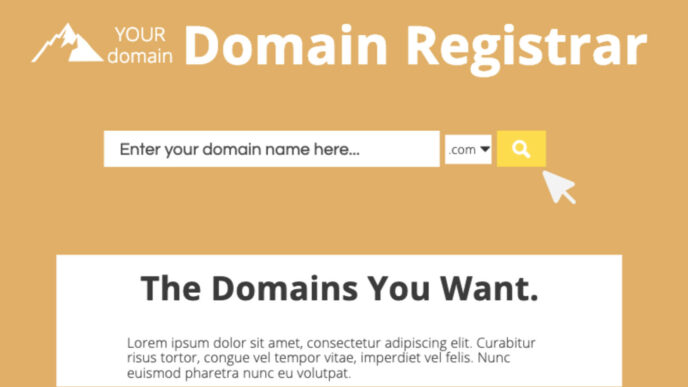
You can choose the TLD you prefer in the select box next to the search field.
Click the search button and the page will load to let you know if it’s available along with other variations, and the domain name cost.
Buying an Expired Domain Name
At this point, you may be wondering if it’s possible to buy a domain back after it has expired. The good news is, if you renew it within the grace period, you can still keep it.
Every domain registrar differs, but this can be anywhere from 30 to 90 days. Sometimes, the grace period is entirely dependent on the type of TLD of the domain. The grace period could be as low as ten days or even zero.
So, it’s definitely worth it to check the fine print with the domain registrar before finalizing your order.
Most of the time, you’ll get an email to notify you in advance that your domain name is expiring soon. Often, you’ll also get offers to renew early at a discount, which can help to bring down domain name costs. Then, you can log in, select your domain name for renewal and check out.
In many instances, you can also search specifically for expired domains that you can buy as well. You can check the documentation of your registrar or contact them for specific steps.
Final Answer: How Much Does a Domain Name Cost?
With all that said and done, how much does a domain name cost at the end of the day? The answer isn’t so straightforward. Depending on the domain name and its value, expect to pay anywhere between an average of ten dollars to thousands of dollars. It also depends on the sales and offers that are available at the time you purchase your domain, and sometimes you can snag a great deal.
There’s also a yearly renewal fee of around $10 to $25, or up to a couple of hundred dollars. It all depends on the domain extension. Sometimes it makes sense to spend a lot and invest in your site or business; other times, a simple $10 domain will be more than fine.
Whatever you decide to do, go with the best you can afford, as well as what will make the most sense for your site, business and goals.
Are you still wondering about domain name costs? All sorted?




All comments are held for moderation. We'll only publish comments that are on topic and adhere to our Commenting Policy.